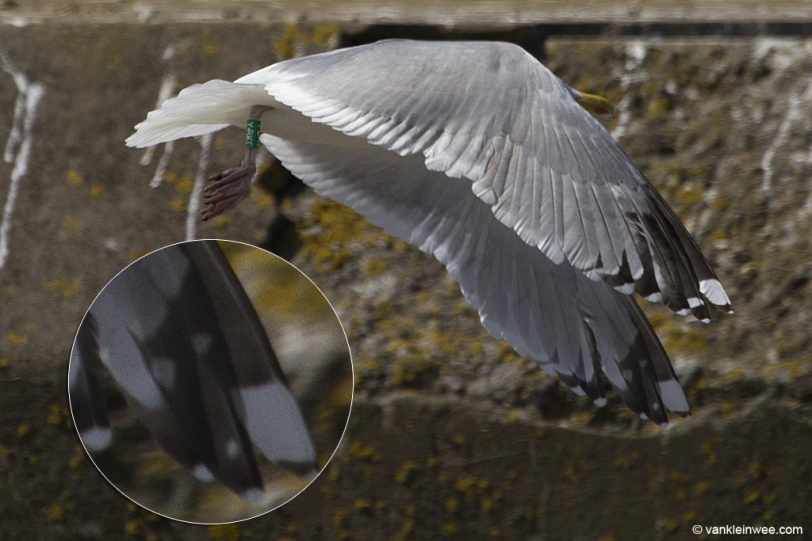In a very interesting blog post on birdingfrontiers.com in 2013 titled A new feature for identifying adult American Herring Gull, the presence of “gray mirrors” on the underside of P9 and/or P10 were presented (in combination with other features) as a possible way of distinguishing an adult American Herring Gull Larus smithsonianus from its European counterparts European Herring Gull Larus argentatus argenteus and Scandinavian Herring Gull Larus argentatus argentatus.
The same article already referred to examples of such isolated gray spots (also referred to as ‘pseudo-mirrors’) occurring in Scandinavian Herring Gulls as well as presumed hybrids Herring Gull x Glaucous Gull in Iceland, but it has only rarely been documented in European Herring Gull (I know of only 2 observations by Kent Olsen in Denmark and one observation of myself in Stockholm, Sweden recently; see the references to his blog at the end of this article).
This week I came across a Dutch example for the first time in the form of European Herring Gull Green YBKC, an adult from the gull colony of IJmuiden (Forteiland), the Netherlands.
Green YBKC was ringed as an adult female in the colony in 2013 and is therefore now older than 6 calendar years. As can be seen in the image, P9 and P10 have an isolated gray spot on the inner web in the left wing. The right wing does not show this pattern.
Comparison with 2014
Interestingly, the primary pattern of YBKC in the previous year was different, showing no such gray pseudo mirrors, although a tiny indentation can be seen along the edge of P10 in the left wing. The following images were taken in the same colony in June 2014:
Other differences in the primary pattern can also be seen, such as the amount of black on P5 (full band in 2015, outer web only in 2014) and the size of the mirror on P9 (larger in 2014 than in 2015).
It should be noted here that the long tongue on P10 is not the pattern that we attribute to a standard European Herring Gull but more as a characteristic for Scandinavian Herring Gulls and American Herring Gulls. The uninterrupted black band on P5 however falls well within the variation of European Herring Gulls.
Personally I see no reason not to treat this individual as anything other than a European Herring Gull and am intrigued by the display in variation of the primary pattern over these 2 years. Hopefully we will be able to follow YBKC over the coming years and discover the same feature in other known adult European Herring Gulls.
References
Published articles:
- Identification of adult American Herring Gull by Peter Adriaens & Bruce Mactavish, Dutch Birding 26-3, 2004
- Identification of American Herring Gull in a western European context by Pat Lonergan & Killian Mullarney, utch Birding 26-1, 2004
Examples of pseudo-mirrors on my blog:
- Adult American Herring Gulls, seen from a Dutch perspective – 201402
- Adult Scandinavian Herring Gulls in Stockholm, Sweden – 20150221
Examples of pseudo-mirrors on other blogs:
- Herring Gull with a grey ‘pseudo-mirror’ on the underside of P10 – Kent Olsen, gulldk
- Herring Gull with a grey ‘pseudo-mirror’ on the underside of P9 – Kent Olsen, gulldk


![G[Y.BKC]-20140602-1](https://gullstothehorizon.files.wordpress.com/2015/04/gy-bkc-20140602-1.jpg?w=812)
![G[Y.BKC]-20140602](https://gullstothehorizon.files.wordpress.com/2015/04/gy-bkc-201406021.jpg?w=812)